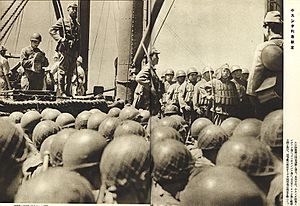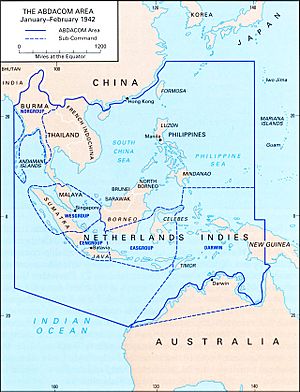Battle of Borneo (1941–1942) facts for kids
Quick facts for kids Battle of Borneo |
|||||||||
|---|---|---|---|---|---|---|---|---|---|
| Part of the Pacific Theatre of World War II | |||||||||
 Japanese paratroopers of the 2nd Yokosuka Naval Landing Force under the command of Lieutenant Colonel Genzo Watanabe (standing on top in the left) inside a transport ship heading to Borneo prior to their invasion in December 1941. |
|||||||||
|
|||||||||
| Belligerents | |||||||||
|
|||||||||
| Commanders and leaders | |||||||||
| Strength | |||||||||
| 4,500 infantry 2 heavy cruisers 1 light cruiser 6 destroyers 1 submarine chaser 1 seaplane tender 1 minesweeper 1 submarine 1 collier 10 transports |
1,000 Sarawak Force 1,000 British Punjab Regiment 1,000 KNIL 650 police 5 fighters Unknown bomber strength 3 flying boats 2 submarines |
||||||||
| Casualties and losses | |||||||||
| 567+ casualties 2 destroyers sunk 1 minesweeper sunk 1 collier sunk 2 transports sunk 1 transport beached 1 transport damaged |
2,300 casualties 1 flying boat destroyed 1 submarine sunk |
||||||||
The Battle of Borneo was a successful military campaign. It took place during World War II. Japanese forces aimed to take control of Borneo island. This included parts of British Borneo and Dutch Borneo. The main Japanese group for this mission was the 35th Infantry Brigade. Major General Kiyotake Kawaguchi led them.
Contents
Why Borneo Was Important
In 1941, Borneo was divided. Some parts were controlled by the Dutch East Indies. Other parts were British areas. These included North Borneo, Sarawak, Brunei, and Labuan.
The Brooke family, known as the "White Rajahs," ruled Sarawak. They had done so for nearly a century. North Borneo was also a British area. The rest of the island, called Kalimantan, was controlled by the Dutch.
Japan needed natural resources, especially petroleum (oil). Borneo had rich oil fields in places like Tarakan and Balikpapan. Japan wanted to control these oil supplies. This was key to their goal of becoming a major power. Borneo also sat on important sea routes. These routes connected other islands like Java and Sumatra. Controlling Borneo meant controlling these vital routes.
Who Fought in Borneo
Allied Forces

The Allied forces included British and Dutch troops. Their main goal was to protect the oil fields. These were in Miri (Sarawak) and Seria (Brunei). The oil was processed at Lutong.
British forces in Sarawak were called "SARFOR." They had about 1,050 men. This included soldiers from the 15th Punjab Regiment. The local government also had the Sarawak Rangers. These were 1,515 local tribesmen. Lieutenant Colonel C.M. Lane led these forces.
After the attack on Pearl Harbor, the British ordered the oil fields to be destroyed. This was to prevent Japan from using them.
Dutch forces defended an airfield called "Singkawang II." It was near the British border. About 750 Dutch troops protected it. They also had some fighter planes and bombers. Three Dornier Do 24 flying boats were in Pontianak. Lieutenant Colonel Dominicus Mars led the Dutch troops there.
Japanese Forces
Major General Kiyotake Kawaguchi led the main Japanese force. It included the 35th Infantry Brigade. They also had units from the 124th Infantry Regiment. Other units included naval landing forces and engineers.
The Battle Begins
On December 13, 1941, a Japanese invasion fleet left French Indochina. It was a large convoy of ships. They carried the 35th Infantry Brigade. The fleet was not detected.
On December 16, 1941, Japanese troops landed. They quickly took Miri and Seria. They faced very little resistance. A few hours later, Lutong was also captured.
Dutch bombers tried to attack the Japanese ships. On December 17, a Dutch flying boat hit a Japanese destroyer. The Shinonome sank quickly. Other Dutch attacks followed. However, the Japanese found the Dutch airfield. The Dutch bombers had to move to Sumatra.
On December 22, a Japanese convoy left Miri for Kuching. A Dutch submarine, HNLMS K XIV, spotted them. On December 23, the submarine attacked. It sank two Japanese transport ships. Hundreds of Japanese troops were lost. Other troops managed to land.
The British 15th Punjab Regiment fought back. But they were outnumbered. They had to retreat. By the afternoon, Kuching was under Japanese control.
Another Dutch submarine, HNLMS K XVI, also had success. It sank the Japanese destroyer Sagiri. This was near Kuching. Sadly, K XVI was later sunk by a Japanese submarine.
Japanese Advance
Japanese troops captured Kuching airfield on December 25. The British Punjab regiment retreated into the jungle. The Japanese then secured Singkawang on December 29. British and Dutch troops continued to retreat south. They tried to reach other airfields.
Meanwhile, Japanese forces moved north. They occupied Brunei, Labuan Island, and Jesselton. Jesselton is now called Kota Kinabalu.
On January 18, 1942, the Japanese landed at Sandakan. This was the main city of British North Borneo. The local police force had only 650 men. They could not stop the invasion. On January 19, Governor Charles Robert Smith surrendered.
The town of Pontianak was taken by Japanese forces on January 29, 1942. Allied troops hid in the jungle for ten weeks. They finally surrendered on April 1, 1942. The Battle of Borneo ended with a Japanese victory.
Images for kids
-
Additional Japanese troops landing off the west coast of British North Borneo in Labuan, 14 January 1942.


